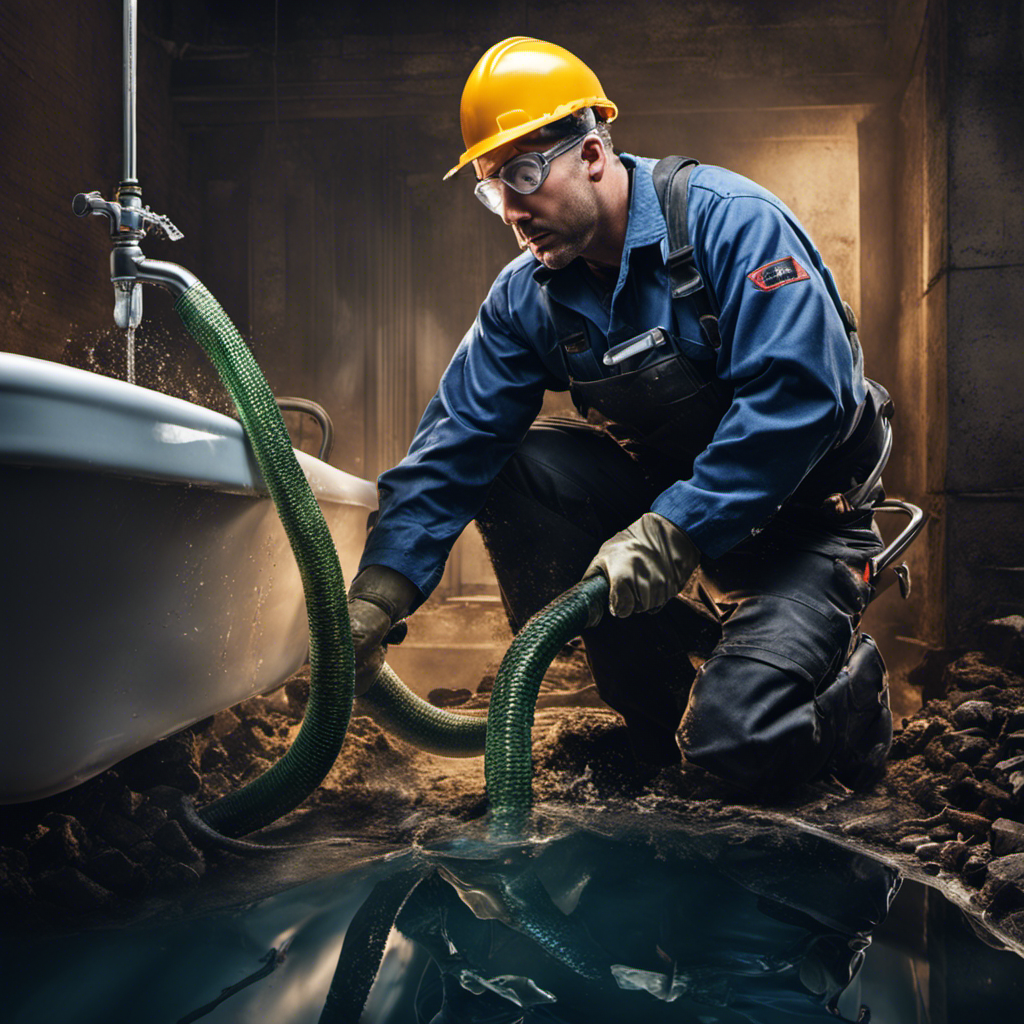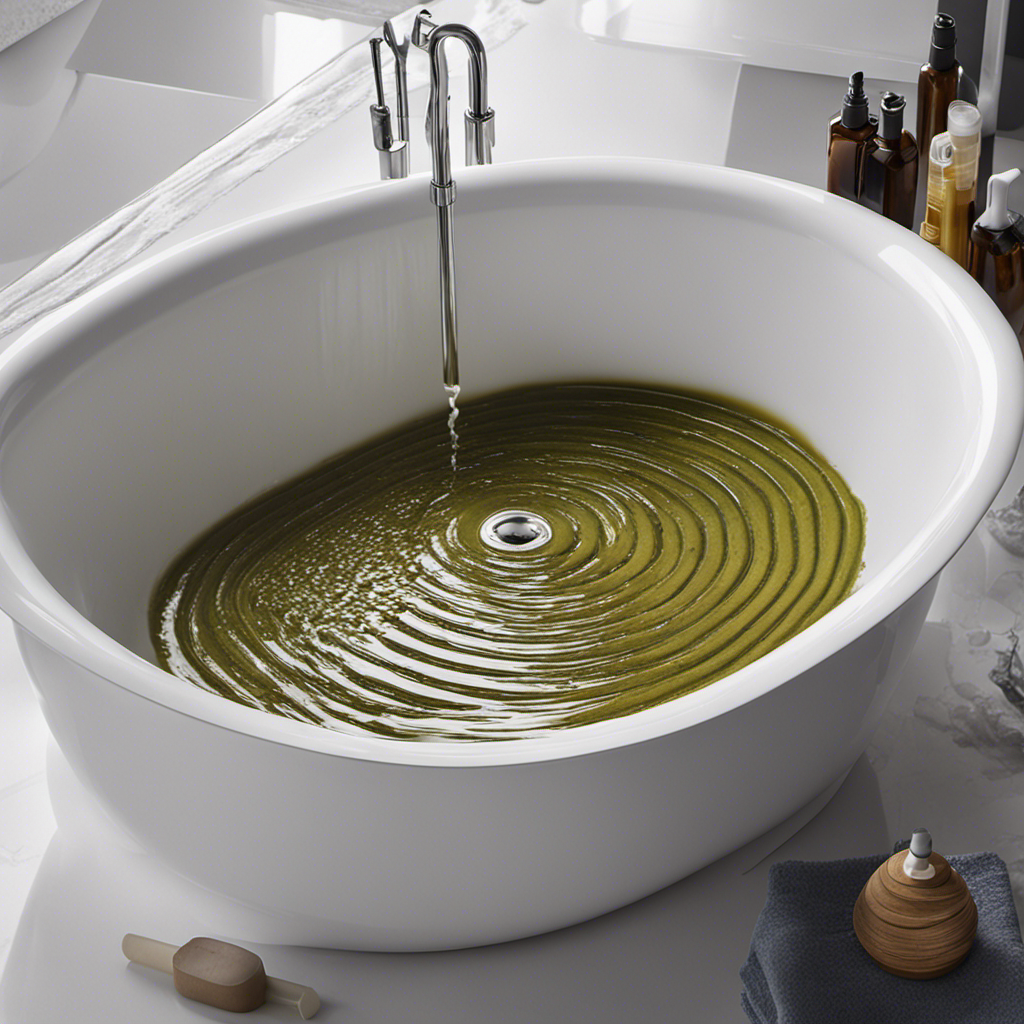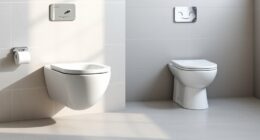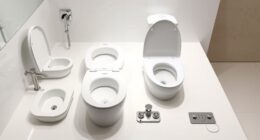Do you find yourself facing a sewer backup in your bathtub? Wondering how to tackle this frustrating problem? Look no further!
In this article, we’ll guide you through the steps to get rid of sewer backup and restore your bathtub to its pristine condition. From identifying the signs and causes of the backup to taking safety precautions and using the right tools, we’ve got you covered.
Say goodbye to sewer backup woes with our expert advice.
Key Takeaways
- Signs of sewer backup in the bathtub include slow draining, gurgling sounds, and unpleasant odors.
- Possible causes of sewer backup include clogs, tree roots intrusion, debris, and grease buildup.
- Preventive measures include regular drain cleaning, proper disposal of waste, and tree maintenance.
- DIY methods to deal with sewer backup include plunging the drain, snaking the drain, using chemical drain cleaners (following instructions), or calling a professional plumber if necessary.
Signs of Sewer Backup in Bathtub
You’ll notice signs of sewer backup in your bathtub, such as slow draining, gurgling sounds, and unpleasant odors. These signs indicate that there is a blockage in your sewer line, causing wastewater to back up into your bathtub.
The main causes of bathtub backup are usually clogs or obstructions in the sewer line, such as tree roots, debris, or grease buildup.
To clear the bathtub backup, you can start by trying to manually remove any visible debris or hair from the drain using a plunger or a drain snake. If that doesn’t solve the problem, you may need to use a chemical drain cleaner or call a professional plumber to inspect and clear the blockage.
Causes of Sewer Backup in Bathtub
One of the common causes of sewer backup in the bathtub is a clogged drain. When the drain gets blocked, it prevents the wastewater from flowing freely, leading to a backup in the bathtub.
Here are some other causes to be aware of:
- Tree roots intrusion: Roots from nearby trees can infiltrate the sewer line and cause blockages over time.
- Aging pipes: Older pipes are more prone to damage and collapse, leading to sewer backups.
- Flushed items: Flushing non-biodegradable items such as wipes, feminine hygiene products, or excessive toilet paper can cause clogs in the sewer line.
To prevent future sewer backups in your bathtub, consider taking these preventive measures:
- Regular drain cleaning: Schedule professional drain cleaning to remove any buildup and prevent clogs.
- Proper disposal: Dispose of waste properly, avoiding the flushing of non-biodegradable items.
- Tree maintenance: Regularly inspect and trim trees near your sewer line to prevent root intrusion.
Steps to Identify the Source of Sewer Backup
To identify the source of a sewer backup, start by inspecting other drains in your home for signs of clogs or slow drainage. This will help you narrow down the location of the problem. There are several common signs to look for when troubleshooting sewer backup issues in your bathtub. These include:
- Water draining slowly or not at all
- Gurgling sounds coming from the drain
- Foul odor coming from the drain
By observing these signs, you can determine if the issue is isolated to your bathtub or if it affects other drains in your home as well. To make it easier for you, here is a table summarizing the steps to troubleshoot sewer backup in your bathtub:
| Steps to Troubleshoot Sewer Backup |
|---|
| 1. Check other drains for signs of clogs or slow drainage |
| 2. Observe water flow and listen for gurgling sounds |
| 3. Take note of any foul odors coming from the drain |
Once you have identified the source of the sewer backup, it is important to take safety precautions before dealing with it further.
Safety Precautions Before Dealing With Sewer Backup
Before dealing with sewer backup, it’s important to ensure you have the proper safety equipment, such as gloves, goggles, and a mask. These safety precautions are essential in preventing accidents and ensuring your personal safety.
Here are a few things you need to keep in mind before you start dealing with sewer backup:
- Wear heavy-duty gloves to protect your hands from harmful bacteria and chemicals.
- Put on safety goggles to shield your eyes from any splashes or debris.
- Use a mask to filter out any foul odors and airborne particles.
By taking these safety measures, you minimize the risk of exposing yourself to harmful substances and potential accidents.
Now, let’s move on to the next section and discuss the tools and materials needed to get rid of sewer backup.
Tools and Materials Needed to Get Rid of Sewer Backup
Now that we’ve discussed the safety precautions, let’s move on to the tools and materials you’ll need to effectively remove the sewer backup. It’s important to have the right tools and materials to ensure a successful cleanup process. Here is a list of the essential tools needed and materials required:
| Tools Needed | Materials Required |
|---|---|
| Plunger | Rubber Gloves |
| Drain Snake | Disinfectant Solution |
| Wet/Dry Vacuum | Trash Bags |
| Bucket | Absorbent Towels |
| Pipe Wrench | Plastic Sheeting |
The plunger is a basic tool that can help you remove the clog by creating pressure in the pipes. A drain snake is useful for breaking up and removing stubborn clogs. A wet/dry vacuum can be used to remove standing water. A bucket will come in handy for collecting debris and wastewater. A pipe wrench is necessary for loosening pipe connections. Rubber gloves should be worn to protect your hands from harmful bacteria. It’s also important to have disinfectant solution, trash bags, absorbent towels, and plastic sheeting to maintain cleanliness and prevent the spread of germs. With these tools and materials, you’ll be well-equipped to tackle the sewer backup in your bathtub.
DIY Methods to Clear Sewer Backup in Bathtub
When faced with a sewer backup in your bathtub, there are several DIY methods you can try before seeking professional plumbing assistance.
The first method involves plunging the drain vigorously to dislodge any clogs.
If plunging doesn’t work, you can try snaking the drain using a flexible cable to break up and remove the blockage.
Another option is to use chemical drain cleaners, which can dissolve organic matter and clear the pipes. However, it’s important to use these cleaners with caution and follow the manufacturer’s instructions.
If all else fails, it may be necessary to call a professional plumber to diagnose and fix the issue.
Plunging and Snaking
To unclog a sewer backup in your bathtub, you can use a plunger or a snake.
Plunging techniques involve creating a seal around the drain with the plunger and applying downward pressure to dislodge the clog. Make sure to cover the overflow drain with a wet cloth to create better suction. Use short, rapid plunges followed by a strong pull to remove the clog.
Snaking equipment, such as a drain auger or a plumber’s snake, can also be effective in clearing stubborn blockages. Insert the snake into the drain and rotate it clockwise while pushing forward. Once you reach the clog, continue rotating and pushing until the obstruction is broken up. Remember to wear gloves and follow safety precautions when using snaking equipment.
Chemical Drain Cleaners
For a quick and easy solution, consider using chemical drain cleaners to break up stubborn clogs in your pipes.
Chemical drain cleaners are powerful substances designed to dissolve and remove debris, hair, grease, and other common causes of blockages in your plumbing system. They work by generating heat and releasing chemicals that break down the clogs, allowing water to flow freely again.
It is important to carefully follow the instructions provided by the manufacturer when using chemical drain cleaners to ensure your safety and to avoid damaging your pipes.
While chemical drain cleaners are effective, they are not without their drawbacks. They can be harmful to the environment and may cause damage to older or delicate pipes.
If you prefer natural remedies, there are alternative options available that are safer for the environment and your plumbing system.
Professional Plumbing Assistance
Now that you know the limitations of chemical drain cleaners, it’s time to consider professional plumbing assistance for tackling sewer backup in your bathtub. When dealing with a sewer backup, it’s essential to act quickly to prevent overflow and further damage to your property. Hiring emergency plumbing services can provide you with the expertise and equipment needed to address the issue effectively.
Here are three reasons why professional plumbing assistance is the way to go:
-
Experience: Plumbers are trained professionals who have dealt with various plumbing problems, including sewer backups. They have the knowledge and experience to identify the root cause of the issue and provide appropriate solutions.
-
Specialized equipment: Plumbing professionals have access to specialized tools and equipment that are specifically designed to handle sewer backups. This ensures a more efficient and effective resolution of the problem.
-
Long-term solutions: By hiring professional plumbers, you can be confident that the issue will be resolved properly, providing you with a long-term solution and preventing future sewer backups in your bathtub.
Hiring a Professional Plumber to Fix Sewer Backup
You should consider hiring a professional plumber to fix the sewer backup in your bathtub. While it may be tempting to try and tackle the issue yourself, hiring a professional not only ensures that the problem is properly diagnosed and fixed, but it can also save you time, money, and potential headaches.
Here is a table that outlines the potential costs of hiring a professional plumber for sewer backup assistance:
| Service | Average Cost |
|---|---|
| Initial Inspection | $100 – $300 |
| Drain Cleaning | $150 – $500 |
| Pipe Repair or Replacement | $500 – $2,000 |
| Sewer Line Excavation | $3,000 – $15,000 |
| Total Cost (approximate) | $750 – $17,800 |
As you can see, the cost of professional assistance can vary depending on the extent of the problem. However, investing in a professional plumber can help prevent further damage to your plumbing system and ensure a long-term solution to your sewer backup issue.
Preventive Measures to Avoid Future Sewer Backup
To effectively prevent future sewer backup issues, there are several key preventive measures you can take.
First, make sure to regularly inspect and maintain your sewage system, including the pipes, drains, and septic tank.
Additionally, consider installing a backwater valve to prevent sewage from flowing back into your property during heavy rains or flooding.
Effective Preventive Measures
One effective preventive measure is to regularly pour a mixture of hot water and vinegar down the bathtub drain. This simple maintenance task helps to prevent sewer backup by clearing any debris or buildup that may be blocking the drain. The hot water helps to dissolve any grease or soap residue, while the vinegar acts as a natural disinfectant and deodorizer.
To perform this maintenance task, follow these steps:
- Mix equal parts of hot water and vinegar in a container.
- Slowly pour the mixture down the drain.
- Let it sit for about 15 minutes.
- Flush the drain with hot water to rinse away any remaining residue.
Long-Term Sewer Backup Prevention
Regularly performing maintenance tasks like pouring hot water and vinegar down your drains can help prevent debris buildup and potential sewer backup problems. However, it’s important to remember that even with regular maintenance, sewer backups can still occur. That’s why it’s crucial to have sewer backup insurance to protect your home and belongings from the financial and emotional devastation that can result from a sewer backup.
Sewer backup insurance provides coverage for damages caused by a sewer backup, including the cost of repairs, cleanup, and replacing damaged items. It gives you peace of mind knowing that you won’t be left with a hefty bill if a sewer backup occurs.
But don’t rely solely on insurance. Regular plumbing maintenance is key to preventing sewer backups in the first place. Here is a table outlining the importance of regular plumbing maintenance:
| Benefits of Regular Plumbing Maintenance |
|---|
| 1. Prevents sewer backups |
| 2. Extends the lifespan of your pipes |
| 3. Improves water flow and efficiency |
| 4. Reduces the risk of costly repairs |
| 5. Promotes a healthy and safe home |
Common Mistakes to Avoid When Dealing With Sewer Backup
Avoiding these mistakes can help you effectively deal with sewer backup in your bathtub. Here are some common mistakes to avoid and signs to look out for:
-
Ignoring slow drainage: If you notice that your bathtub is draining slowly, it could be a sign of a potential sewer backup. Ignoring this issue can lead to a complete blockage and cause wastewater to overflow into your bathtub.
-
Using chemical drain cleaners: While it may seem like a quick fix, using chemical drain cleaners can actually worsen the problem. These cleaners can corrode your pipes and cause further damage, making the backup even worse.
-
Neglecting regular maintenance: Regular maintenance is crucial in preventing sewer backup. Neglecting to schedule regular inspections and cleanings can result in blockages and backups that could have been avoided.
When to Call the Sewer Department for Backup Assistance
If your drains are consistently slow and emitting a foul odor, it may be time to call the sewer department for backup assistance. Sewer backups can cause serious damage to your home and health hazards, so it’s important to take action promptly. Here is a step-by-step guide to help you know when to contact a professional plumber and the steps to take after clearing the sewer backup:
| When to Contact a Professional Plumber | Steps to Take After Clearing Sewer Backup |
|---|---|
| If multiple drains are clogged | Inspect for any visible damage or leaks |
| If plunging or snaking doesn’t work | Flush the drains with hot water |
| If foul odors persist despite cleaning | Use a bacterial drain cleaner |
| If you suspect a main sewer line issue | Schedule a professional inspection |
Frequently Asked Questions
Can I Use Chemical Drain Cleaners to Clear a Sewer Backup in My Bathtub?
Using chemical drain cleaners may temporarily clear a sewer backup in your bathtub, but it is not recommended. These cleaners can be harmful to your pipes and the environment. Consider alternative methods like using a plunger or calling a professional plumber.
How Long Does It Typically Take to Clear a Sewer Backup in a Bathtub?
Are you tired of dealing with sewer backups in your bathtub? Learn how to prevent them by properly maintaining your plumbing system. Look out for signs of a backup, such as slow draining or foul odors.
Are There Any Home Remedies That Can Help Prevent Sewer Backups in the Future?
To prevent future sewer backups, you can try using home remedies and taking preventive measures. These can include regularly cleaning your drains, avoiding flushing non-biodegradable items, and installing a backwater valve.
Can a Sewer Backup in the Bathtub Cause Damage to My Plumbing System?
A sewer backup in the bathtub can cause significant damage to your plumbing system. It is crucial to take preventive measures, such as regular maintenance and inspections, to avoid potential issues and costly repairs.
What Are the Potential Health Risks Associated With a Sewer Backup in the Bathtub?
To prevent potential health risks associated with a sewer backup in the bathtub, it’s important to take preventive measures. Regularly clean your drains, avoid flushing non-flushable items, and consider installing a backwater valve to prevent backups.
Conclusion
To wrap things up, tackling a sewer backup in your bathtub can be quite a task. However, with the right tools and precautions, you can successfully get rid of the issue.
Remember, it’s always best to hire a professional plumber for complex problems or if you’re unsure about handling the backup yourself.
Additionally, taking preventive measures such as regular maintenance and avoiding common mistakes can help you avoid future sewer backups.
And if all else fails, don’t hesitate to reach out to the sewer department for backup assistance.










